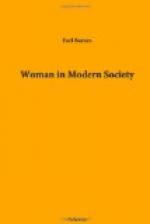But while every new movement in ideas always carries with it other radical ideas, the practical difficulties of mental, social and legal adjustment always prevent the full and harmonious development of all that is involved in any new point of view. In the American colonies the need for new adjustments in religion, government and practical living made it inevitable that any very important change in woman’s position should linger. In fact, the student of colonial records finds many traces of ultra conservatism in the treatment of women, though the forces had been liberated which must inevitably open the way for her through the New World of America into a new world of the spirit.
And before the quickening influence of the new life had time to become commonplace, the struggle with England began. The Revolutionary period was a time of intense political education for every one. War and sacrifice glorified the new ideas; and even the children and women could not escape their influence. Why then did not the American Revolution pass on to full freedom and opportunity for women? For the same reason that it did not forever abolish slavery in America. The vested interests involved were so many, and the changes so momentous and difficult, that only the most imperative needs could receive attention.
But this does not mean that the interest in a larger life for women was not active or that women were making no advance in self-direction. There is evidence that women like Abigail Adams realized the abstract injustice of their position, and the fact that as early as 1794, Mary Wollstonecraft’s “Vindication of the Rights of Woman” was republished in Philadelphia shows that her ideas must have had some currency in America.
After the Revolution, the intimate, stimulating influence of Europe, which the earlier colonists had enjoyed, was for a time almost entirely lost. The new States became extremely provincial; and minds untouched by the larger world always tend to conservatism. Noah Webster, in “A Letter to Young Ladies,” published in Boston, in 1790, declared that they “must be content to be women; to be mild, social and sentimental.” Three years later the “Letters to a Young Lady,” by the Reverend John Bennett, were republished in Philadelphia, after going through several London editions. He placed the qualities to be cultivated in this order: “A genteel person, a simple nature, sensibility, cheerfulness, delicacy, softness, affability, good manners, regular habits, skill in fancy work, and a fund of hidden genteel learning.” Through the first half of the nineteenth century these ideals struggled along parallel with the new ideas that were everywhere springing up from the colonial forest experiences of the last two generations.
As conservers of morals and as leaders in higher ideals of life, the advanced women of America came early face to face with two outgrown abuses. One of these was human slavery and the other was intemperance. In attacking these abuses, women had to break with all the traditions that defined their position.




